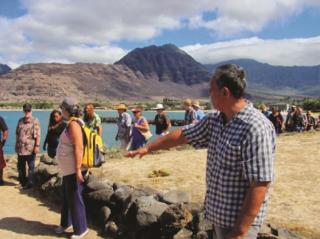Interfaith 'Ohana, a Hawaiian Story

One Sunday in January 2012, in the sanctuary, the First Unitarian Church of Honolulu shared worship with Kanenuiakea, an indigenous Hawaiian religious community. Few in the Unitarian Universalist (UU) congregation had ever before witnessed chanting and dance in celebration of Kane (KAH-nay), the Hawaiian god of the sun, daylight, and Creation.
The service was also a first for Kanenuiakea. The religion, though hundreds of years old, has been practiced entirely in secret since the Hawaiian Kingdom and its Constitution were overthrown in 1893. And, Kane is traditionally honored out of doors, at sacred sites called heiau (HAY-ow)—never indoors, not for 120 years.
“Quickly we recognized a kindred people,” recalls Steve Lohse, a lifelong Unitarian, who led the congregation’s Social Justice Council to invite the indigenous group. “Their religion has principles and values that resonate with UU Principles.” For example, aloha means a way of life in harmony and balance, treating ourselves and others with love, respect, trust, and support. ‘Ohana means family. It is about our interconnectedness with everyone and everything in the universe through cooperation and the sharing of knowledge and skills from one generation to the next. After that Sunday, the door swung open. Kanenuiakea leaders helped write a curriculum to teach UU children about traditional Hawaiian values. Kanenuiakea also invited the UUs on hikes to heiau in the Waianae mountains; together, they cleaned the grounds, watered plants, and shared worship rituals and food.
Long ago, the Waianae volcanic mountain range and its surrounding ocean supported Kanenuiakea ancestors who farmed and fished for their livelihood. But indigenous Hawaiians suffered as American settlers took over the land, diverted water for their own use, and suppressed Native Hawaiian culture, language, and religion. The UU congregation came to understand that, for Kanenuiakea, the public worship in their sanctuary had been a brave act of trust.
Still, today, business and government make demands on the land. For example, the University of Hawaii wants to add a large telescope to the observatory atop Mauna Kea, the tallest mountain in Hawaii and considered especially sacred. Many Native Hawaiians oppose this. Some UUs have worked with Kanenuiakea to record oral histories about traditional use of the land, document sacred sites with GPS equipment, and register the sites with government agencies that can protect them. By the time Glen Kila, the kumu (ancestral leader) of Kanenuiakea, approached the Unitarian Universalists for support, the trust and respect of a good partnership were already in place. Leaders of the two communities shared ideas for what the congregation could do.
As a result, in April, UU minister Jonipher Kwong and Susan Lebo, a congregational leader who is currently the chief archaeologist for the State of Hawaii, wrote to Hawaii’s governor about Mauna Kea. The letter respectfully offered an approach rather than demanding an action:
Because we affirm and promote justice, equity, and compassion in human relations and the inherent worth and dignity of every person...we are concerned that various communities do not feel equitably represented over Mauna Kea, and we offer...[a] plea for leadership and healing.
Shortly afterward, Hawaii’s governor announced a new plan for both sides to be heard: an example of the power we can find in interfaith witness...and partnership.